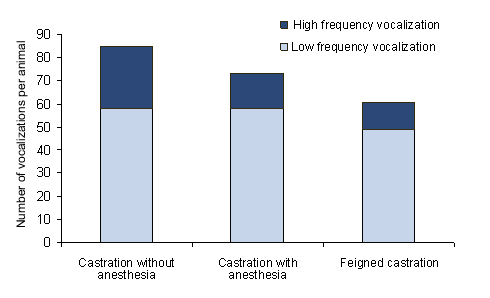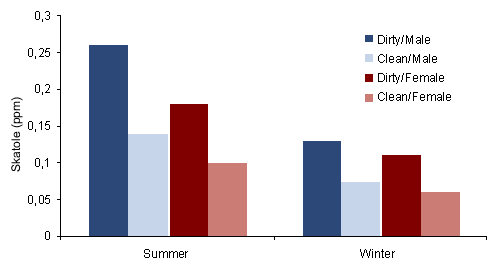Surgical castration with anesthesia
The administration of local or general anesthesia, accompanied in all cases by a long-lasting analgesic, eliminates or considerably reduces the pain caused by surgical castration. However, the use of these products has certain limitations. Firstly, their use in animals destined for human consumption is subject to the maximum residue limits of veterinary medicinal products in foodstuffs of animal origin in accordance with Regulation (EEC) No 2377/90. Secondly, their administration increases the cost and time necessary for each castration. There are currently no specific anesthetic protocols for the castration of piglets in commercial conditions.
Ketamine, ketamina + xylazine or tiletamine administered intravenously are some of the pharmaceuticals that have been proposed to induce general anesthesia during castration. However, these anesthetics induce long periods of sedation which increases the risk of death by hypothermia or crushing. Inhalation of isoflurane, halothane or carbon dioxide (CO2) also induces a general anesthesia in the animal. The use of isoflurane or halothane requires a suitable ventilation system, since it can be dangerous for the personnel. Moreover, inhaling halothane can induce malignant hypothermia in certain pig breeds. Anesthesia with CO2 can be easily applied in commercial conditions without the need for an evacuation system for an excess of gas. However, inhalation of high concentrations of CO2 has been highly criticized from the point of view of animal welfare. Firstly, because CO2 is an acidic gas, and so its inhalation causes irritation of the mucous membrane. And secondly, because it is a potent respiratory stimulator that causes hyperventilation and the sensation of asphyxia before the loss of consciousness.
In general, the administration of a local anesthetic is the most usual method to eliminate or reduce the pain caused by castration. The injection of lidocaine inside the testicle and the scrotum, around the funicular area (close to the spermatic cord), induces the insensibility of the zone and reduces the perception of pain during the castration. In anesthetized animals, the number of the high frequency vocalizations associated with pain is lower than in animals castrated with anesthesia (Figure 1). If it is administered together with adrenaline, the efficiency of the anesthesia increases, as it spreads more efficiently to the affected tissues and decreases the effective dose of lidocaine. The analgesic effect induced by lidocaine and adrenaline disappears after 3-4 h, so they should be administered together with other analgesics to reduce the pain for at least 24 h.
Figure 1. Effect of castration without anesthesia, with anesthesia or feigned on the number vocalizations emitted by piglets.

Production of intact males
As well as eliminating the pain associated with castration, breeding intact males also presents certain advantages with respect to the production of barrows (Table 1). For the production of intact males to be economically viable it is necessary to have the means to control the presence of boar taint in the carcass. In the United Kingdom and Ireland, where practically no pigs are castrated, animals are slaughtered at a lower weight (74 and 71 kg carcass weight average, respectively), which reduces the amount of carcasses with boar taint. However, by reducing the carcass weight, the production costs per kg of liveweight increase.
Table 1: Advantages and disadvantages of the production of intact males.
|
Advantages
|
Disadvantages
|
| Greater alimentary efficiency | Increase of aggressions and mountings |
| Leaner carcasses | More damage in the carcass |
| Higher content of unsaturated fatty acids |
Greater incidence of DFD |
| Lower excretion of nitrogen | Blander fat |
| Lower production costs | Greater incidence of boar taint |
The most effective mechanism for reducing the androstenone levels seems to be genectic selection. Androstenone is highly inheritable; however, selection against this substance reduces its production and that of estrogen. Moreover, estrogen has a negative effect on production performance, and in females, it causes a delay in the start of puberty.
The most effective mechanism for controlling the skatole levels is through the diet and the breeding conditions. Humid feed, the incorporation of fiber in the feed, or materials with a high content of carbohydrates of low digestibility in the small intestine, but easily fermentable in the large intestine (pectins, potato starch, etc.) produce a reduction in the levels of skatole.
The skatole content is lower in pigs accommodated on a slatted floor than on a continuous compact floor (Kjeldsen, 1993). The skin of the pig is very permeable to skatole, so that once excreted, if the animal comes into contact with the feces, the skatole is absorbed and accumulates in fat (Figure 2). Therefore, it is recommendable to keep the animals clean, especially in the final weeks before slaughter. For this reason, in hot periods, the possibility for the pigs to regulate themselves thermally without the need to roll in excreta, considerably reduces the skatole levels.
Figure 2. Effect of season, sex and cleanliness of the animal on skatole levels.

The application of the above described measures considerably reduces the incidence of boar taint, but does not guarantee its absence in all the carcasses.




